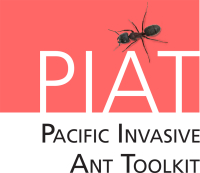Black crazy ant
|
lives in trees |
lives on ground |
day active |
night active |
Scientific name: Paratrechina longicornis
Other common name: longhorn crazy ant; brown crazy ant
Size: 2.3-3 mm
Colour: dark brown to blackish
|
Black crazy ant workers feeding on tree sap (© Phil Lester) |
A close-up of a black crazy ant carrying a larvae (Source: © Eli Sarnat, Creative Commons Attribution, Share Alike CC BY-SA Licence) |
General description: the black crazy ant, like other crazy ants, gets its name from its very fast, erratic movement when disturbed. This ant is very hairy and has very long legs and antennae, unlike many similar ants, its hairs are white
Habitat and nesting: the black crazy ant has a broad environmental tolerance ranging from very dry to quite damp habitats. The ant is typically found in disturbed natural environments, urban areas, farms, ships and some native tropical vegetation. Nests may be found on the ground under wood or in rotting logs, in sand or concrete or under rubbish or mulch. Black crazy ants also occasionally nest in tree holes and leaf axils.
Rate of spread: unknown.
Distribution: see our invasive ant distributions page for the worldwide distribution of the black crazy ant.
Reproduction: black crazy ants reproduce clonally, which is suggested to assist their invasion success.
Video of black crazy ants foraging on a sugar bait in Fiji, Vimeo video (© Eli Sarnat, Creative Commons Attribution, Share Alike CC BY-SA Licence) |
Video of black crazy ants foraging in Hawaii, note how quick they are, Vimeo video (© Eli Sarnat, Creative Commons Attribution, Share Alike CC BY-SA Licence) |
|
For detailed descriptions and identification of black crazy ants: PIAkey: Paratrechina longicornis (see diagnostic characters tab) AntWeb: Paratrechina longicornis Social, agricultural and environmental impacts of the black crazy antBlack crazy ants can forage an unusually far distance from their nest, making them difficult to treat. |
Black crazy ant worker (© Alex Wild) |
Information sources
AntWiki, Black crazy ant
Biosecurity New Zealand invasive ant threat information sheet number 20, Black crazy ant
Centre for Agriculture and Bioscience International (CABI), Invasive Species Compendium, Black crazy ant
Global Invasive Species Database (GISD)
Global Register of Introduced and Invasive Species (GRIIS)
Island Biodiversity and Invasive Species Database (IBIS)
Pearcy, Goodisman, Keller. 2011. Sib mating without inbreeding in the longhorn crazy ant. Proceedings of the Royal Society of London. Series B: Biological Sciences 278, 2677-2681
PIAkey, Black crazy ant
Content reviewed by Eli Sarnat, Antwork Consulting, LLC, June 2017



